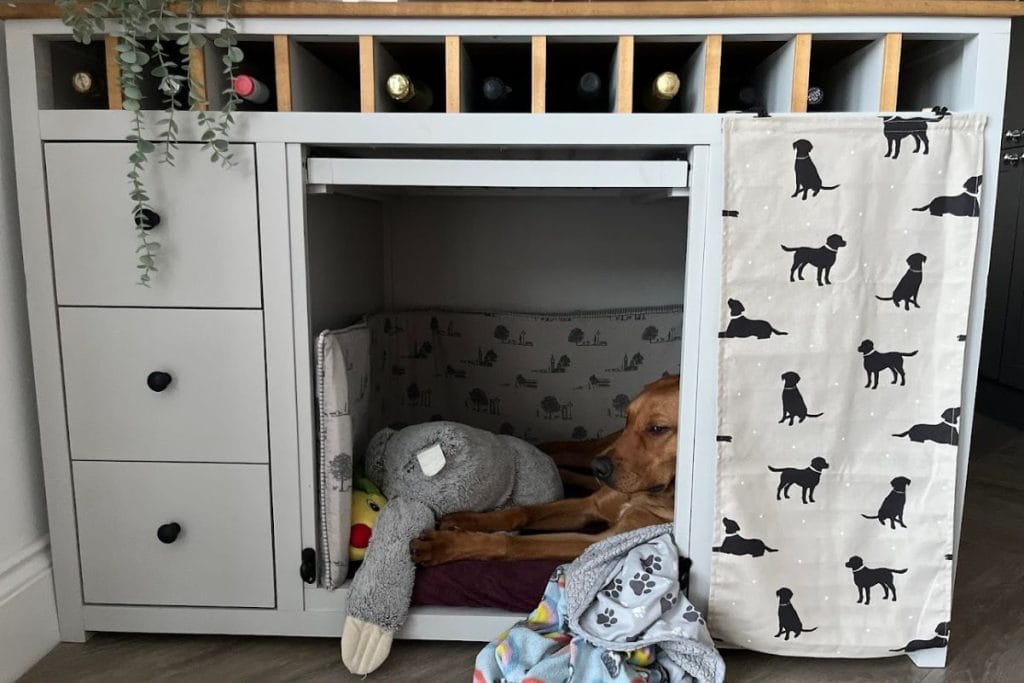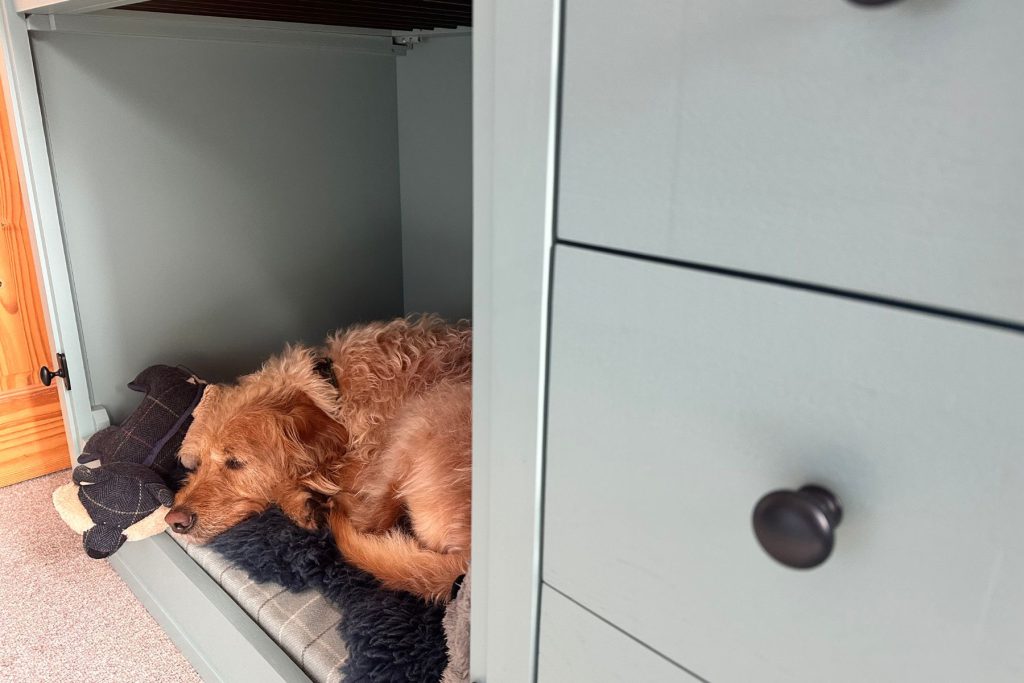Understanding Comfort, Confidence and Calm
At The Pet Carpenter, we believe crate comfort isn’t just a feeling, it’s behaviour in action. The space a dog calls their own influences how they rest, how they cope with change, and how they build confidence when life gets busy.
“Crate confidence” isn’t about confinement, it’s about creating comfort through design. When introduced positively, a dog’s crate can become their sanctuary, a safe, familiar environment that encourages rest, calm and independence.
Recent behavioural research shows that thoughtfully designed crate spaces don’t just look beautiful in the home, they also play an important role in supporting a dog’s emotional wellbeing.
Why a Crate Can Be a Comfort Zone
Many dog owners associate crates with training or management, but when used correctly, they become so much more. A crate can give a dog:
- A sense of predictability, helping them understand where they can go to relax.
- Security, especially useful during fireworks, busy gatherings or vet recovery.
- Choice, a private retreat when they want time away from noise or stimulation.
The Generation Pup longitudinal study (Cambridge University Press, 2024) found that puppies who experienced calm, consistent early routines and had access to safe spaces such as crates were less likely to develop separation-related behaviours later in life. In other words, comfort created early becomes confidence for life.
The Science of Crate Comfort
1. Calm Starts with Positive Association
The Karen Pryor Academy highlights that the most successful crate training relies on choice and reward. By allowing dogs to enter freely, and pairing that behaviour with comfort cues such as treats, soft bedding or calm praise, the crate becomes a place of reward and rest, not restriction.
2. Design Shapes Behaviour

Research published in Applied Animal Behaviour Science (2024) shows that well-designed enclosed environments can act as therapeutic spaces. For dogs in recovery, or those prone to overstimulation, the right design can encourage emotional self-regulation.
Features such as:
- Adjustable visibility (roll-down curtains or partial covers);
- Warm, natural materials;
- Soft surfaces that invite relaxation;
all contribute to lower stress responses and calmer behaviour.
3. Environment Matters
Studies in MDPI’s Animals Journal (2023) found that enriched environments, those that feel calm, predictable and secure, directly reduce stress indicators such as cortisol and heart rate. At The Pet Carpenter, we see this every day. When design meets behavioural understanding, dogs naturally choose to rest more peacefully.
Design Choices That Support Behaviour
Every detail of a bespoke dog crate has the potential to influence wellbeing.
| Design Feature | Behavioural Benefit |
| Right Sizing | Helps dogs feel contained yet comfortable, encouraging relaxation without restriction. |
| Soft Furnishings | Textures and warmth promote calm and physical comfort. |
| Adjustable Visibility | Allows control over light and stimulation, perfect for dogs needing quiet space. |
| Pet Safe Materials | Build trust and reduces risk of discomfort or injury. |
| Integrated Design with the Home | Encourages owners to keep the crate in central, social spaces where dogs feel included but safe. |
By blending design expertise with behavioural science, crate spaces can help dogs thrive emotionally and look stunning in any home.
Real Stories of Comfort and Confidence
From veterinary professionals to everyday owners, our clients tell us that good design changes everything.
“Beau knows that if he’s unsure with fireworks or tradesmen, he can sit in his crate and watch the world go by.” – Grania Benson, Veterinary Surgeon
“Owning working breed dogs, crate training helps you teach them to switch off their busy brains and get the rest they need.” – Alice Hill, Veterinary Nurse
These aren’t stories of confinement. They’re stories of comfort, calm and connection, where design supports behaviour beautifully.
FAQs
When introduced gently and positively, crate training is never cruel. It provides a space where dogs can rest and feel secure. Problems only arise when crates are used as punishment or dogs are left inside for long periods without exercise or interaction.
A dog should be able to sit, stand, turn around and stretch comfortably without impact on natural gait. Too much space can make them feel exposed, too little restricts comfort. The Pet Carpenter’s Pet Furniture Size Guide can help you understand ideal sizing for your dog.
Adult dogs should have regular breaks every few hours. Puppies, older dogs or those new to crates may need more frequent time out.
It’s our belief that every dog guardian should gift their dog their own safe space; a cosy, safe retreat that builds confidence and calm. Through comfort-led design, we help dogs, and their owners, fall in love with the idea of rest.
Further Support with Crate Training my Dog
We know that every dog learns differently, and sometimes a little extra guidance can make all the difference.
If you’d like expert help building your dog’s crate confidence, our partners at The Dog Trainer School can connect you with trusted, force-free, welfare-led training professionals across the UK and beyond.
You can explore these trusted partners and find practical guidance through our Dog Training Resources page.
Comfort by Design
A dog’s crate isn’t simply a piece of furniture, it’s a reflection of the relationship between owner and pet. At The Pet Carpenter, we create spaces that celebrate that bond, beautiful, functional and tailored for emotional wellbeing.
When comfort is designed thoughtfully, confidence follows naturally.
Explore our bespoke designs and discover how we can help you create a calm, stylish retreat your dog will truly call home.
Research & Welfare Statement
At The Pet Carpenter, we are committed to promoting comfort, choice and welfare in every product we design. Our philosophy is informed by research from:
- Generation Pup Longitudinal Study (Cambridge University Press, 2024)
- Karen Pryor Academy Crate Training Guide
- Cornell University College of Veterinary Medicine
- Applied Animal Behaviour Science (2024)
- MDPI “Animals” Journal (2023)
Each of these studies supports the concept that crates, when introduced positively and designed for comfort, can enhance a dog’s emotional security, reduce stress and encourage healthy independence.
